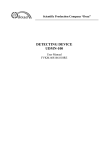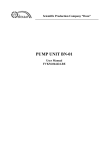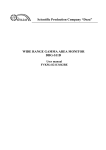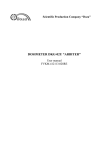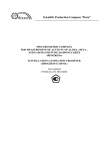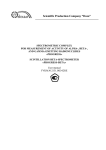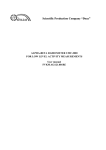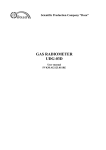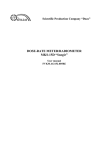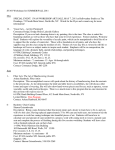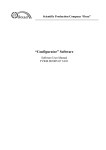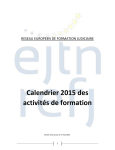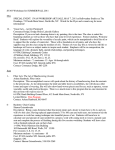Download User Manual
Transcript
Scientific Production Company “Doza” DOSIMETER DKG-07D “DROZD” User manual FVKM.412113.026RE Cont ent 1 Description and operation of the product ……………………..……………. 1.1 Product functionality …………………………………….………… 1.2 Technical characteristics …………………………..………………. 1.3 Design and operation …………....………………..………………... 1.4 Marking and sealing …………....………………...………………... 1.5 Packing ………………………………...…………………………... 2 Intended use ……………………………………………..……………….… 2.1 Operational limitations …………………………..………………… 2.2 Preparation of the product for use ..……………...………………… 2.3 Use of a product …….….….………………………………………. 2.4 Adjustment ……………………………….…...…………………… 3 Maintenance ………………………………………...……………………… 3.1 General notes …………………………………..…………………... 3.2 Safety precautions ……………………………………………….… 3.3 Maintenance routine ……………………...………………………... 4 Calibration routine ………………………….…….……………...………… 4.1 General requirements …………………….………............................ 4.2 Preliminary arrangements …………………………….………....… 4.3 Safety precautions ……………………………………………….… 4.4 Conditions …….……….………….………….………….………… 4.5 Procedure …………………….………………...….……………….. 5 Routine repairs ……………………………………..……..………………... 6 Storage …………………………………………………………...………… 7 Transportation …………………………………………….……….……….. 8 Disposal ………………………………………………………….…………. FVKM.412113.026RE 2 3 3 3 4 4 4 5 5 5 5 6 7 7 7 7 8 8 8 8 8 9 10 10 10 11 This User Manual contains information on design, principle of operation, characteristics of the product and instructions essential for correct and safe use of this product (intended use, maintenance, servicing, storage and transportation), as well as information regarding the utilization of the product. 1 DESCRIPTION AND OPERATION OF THE PRODUCT 1.1 Product functionality Dosimeter DKG-07D «Drozd» FVKM.412113.026 (hereinafter - dosimeter) is intended for measurement of: * 10 of gamma radiation (hereinafter - AEDR); - ambient equivalent dose rate Н - ambient equivalent dose Н* 10 of gamma radiation (hereinafter - AED). The dosimeter can be used at nuclear plants and facilities, at radiochemistry plants, in industries where radiation sources are used, at special and custom control stations, and by ecological services and sanitary inspections. The dosimeter can also be used by persons from population for individual monitoring of radiation environment. 1.2 Technical characteristics 1.2.1 Energy range of measured gamma radiation …….....………..…….....…. 0.05 to 3.0 MeV. 1.2.2 Measurement range: - AEDR of gamma radiation …………………………………...……... 1·10-1 to 3·103 μSv·h-1 ; - AED of gamma radiation ……………………….………………..………….. 1 to 2·105 μSv. 1.2.3 Limits of the permissible basic relative measurement error of AEDR and AED of ) %; gamma radiation ..………..………..………..…………..….…………….………… (15+2.5/ where H is a dimensionless unit, numerically equal to measured values of measured AEDR or AED in μSv·h-1 and μSv, accordingly. 1.2.4 Energy dependence relative to 137Cs (0.662 MeV) ……………………………….. 25 %. 1.2.5 Anisotropy of dosimeter ……………………………………………………...…… 30 %: - for energies 0.662 and 1.25 MeV and with incidence angle changing from 0° to ±180° relative to the direction used during dosimeter calibration, in vertical and horizontal planes; except the angle 90° in horizontal plane, for which the anisotropy of sensitivity is ……not more than minus 45 %; - for energies 0,06 MeV with angle changing from 0° to ±45° relative to the direction used during dosimeter calibration, in vertical and horizontal planes. 1.2.6 Warm-up time of the dosimeter ….….…..………….…..…..…………. not more than 5 s. 1.2.7 Continuous operation with one set of batteries …….…....………….….……… 200 hours. 1.2.8 Instability of readings during 8 hours of continuous operation relative to average value of readings for this period of time ……………………….……………….……………….………… ±3 %. 1.2.9 Interval of measurement of AEDR .……………...………………...……….… not limited. Not e – In the mode of AEDR measurement the precision of readings is continuously improved in the course measurement. Simultaneously the decreasing value of statistical uncertainty is shown on the LCD that allows to regard the measurement result as final one when the desired precision is reached. 1.2.10 Power supply voltage …………………………...…..……………………… 2.0 to 3.2 V. 1.2.11 Power supply of the dosimeter is carried out from two batteries of AA type, 1.5 V each, with total voltage not more than 3.2 V. 1.2.12 Operating conditions: - operating temperature range ……...….….………………..…….....….. minus 20 to + 50 C; - maximum limit of relative humidity …………….…….….…..…….….…… 90 % at +25 C; - atmospheric pressure …………………………………………….…….… 84.0 to 106.7 kPa. FVKM.412113.026RE 3 1.2.13 Limits of complementary measurement error due to: - deviation of the ambient air temperature from its normal value per 10 C ……...…… ±5 %; - increased relative humidity ………………………………………………..………… ±10 %; - change of the power supply voltage ………………………………….…......………… 5 %. 1.2.14 Degree of protection provided by casings against ingress of solid items and water according to the IEC 529-89 ……………………………………………………………………… IP40. 1.2.15 Dosimeter is stable against short, with duration 5 minutes, overloads with value of AEDR of gamma radiation 0.1 Sv·h-1. After overload the dosimeter operable and maintains basic relative measurement error within normal range. 1.2.16 Dosimeter is stable against: - RF radiation in the band 80 to 1000 MHz with field strength 3 V/m in compliance with IEC 61000-4-3:2006; - electrostatic discharges with voltage ±8 kV (contact discharge and air discharge) in compliance with IEC 61000-4-2-95. 1.2.17 By its protection against electric shock dosimeter complies with the IEC 61010-1:2001. 1.2.18 Dosimeter withstands the exposure of decontamination solutions: - trisodium phosphate or sodium hexametaphosphate (any synthetic detergents) – water solutions 10 - 20 g/l; - 5 % citric acid solution in rectified alcohol. 1.2.19 Weight of the dosimeter, including batteries ……………………..….….………. 0.25 kg. 1.2.20 Overall dimensions of the dosimeter (lengthwidthheight) ..………… 7429122 mm. 1.2.21 Mean time to failure …………….……….………….…..….…. not less than 8000 hours. 1.2.22 Mean life time ……………………….….………….…….……..…. not less than 7 years. 1.3 Design and operation 1.3.1 All modules of the dosimeter are placed in a compact plastic case. A liquid-crystal display (hereinafter - LCD) is provided in the upper part of the dosimeter’s front panel, controls are located in the middle part. 1.3.2 The principle of operation of the dosimeter is based on counting of pulses from GM counter. The built-in converter provides high voltage 400 V for the counter. Data processing is carried out by microprocessor; obtained measurement result is displayed on the LCD. 1.4 Marking and sealing 1.4.1 The following information is presented at the dosimeter’s case: - trademark and name of the manufacturer (supplier); - reference designation of the dosimeter; - works number of a dosimeter according to the manufacturer's system of numeration; - degree of ingress protection against solid items and water provided by casings. 1.4.2 The dosimeter is sealed in accordance with the design documentation. 1.5 Packing 1.5.1 The dosimeter is packed into a carton which ensures protection against ingress of atmospheric precipitations and aerosols, splashes of water, dust, sand, solar ultra-violet radiation and also limits the ingress of water vapour and gases. FVKM.412113.026RE 4 2 INTENDED USE 2.1 Operational limitations 2.1.1 Dosimeter retains operability under conditions stated in sect. 1.2. 2.1.2 Avoid dropping of a dosimeter; protect it from shocks and exposure to water. 2.2 Preparation of the product for use 2.2.1 Dosimeter is ready for use when batteries are inserted into the battery compartment. In case batteries are not inserted, slide the cover of the battery compartment, insert batteries (observe the polarity) and return the cover in its place. 2.2.2 When the power supply voltage falls below 2.2 V a message “REPLACE BATTERIES” will appear on the LCD. 2.2.3 Turning on/off is performed by pressing the switch located on the upper end of the dosimeter. 2.3 Use of product 2.3.1 Turning on/off 2.3.1.1 Turn on the dosimeter by pressing the power on/off switch and observe the following messages on the LCD: - in the upper line .……………………………… 0.00 Sv·h-1; - in the lower line ……………………………..… ********. 2.3.1.2 After 2-3 seconds in the upper line the value of AEDR will appear and in the lower line – the statistical uncertainty in per cents. Presence of messages mentioned in 2.3.1.1 for more than 10 seconds indicates that the dosimeter is inoperable. 2.3.1.3 To turn the dosimeter off press the power on/off switch. 2.3.2 Selection of measurement mode Dosimeter simultaneously runs in two modes: - measurement of AEDR; - measurement of AED. Current value of one measurand is shown on the LCD. To view the value of another measurand, press the “MODE” button. 2.3.3 Start of measurement Start of measurement in any mode is performed by pressing the “START” button. This will initiate the measurement process of the measurand (AEDR or AED), which is indicated when the button is pressed, while the process of measurement of another measurand (carried out simultaneously) will be continued. 2.3.4 Measurement of AEDR 2.3.4.1 The following information is shown on the LCD during measurement of AEDR: 1) in the upper line – measured value of AEDR in Sv·h-1, with the prefix before the measurement unit: - ……………………………… micro (10-6); - m ……………………...……… milli (10-3). 2) in the lower line – statistical uncertainty of measurement in per cent. 2.3.4.2 Measurement of AEDR in each new point is started after pressing the “START” button. Taking readings from the LCD shall be performed after the moment when statistical uncertainty (indicated in the lower line) has reached the required value. FVKM.412113.026RE 5 2.3.4.3 Measurement interval of AEDR is not limited. In the course of AEDR measurement continuous precision of readings is continuously improved with the increasing of measurement time, at that decreasing value of statistical uncertainty is shown on the LCD. ATTENTION! The dosimeter indicates the mean value of AEDR relevant to the total measurement time. Therefore if the AEDR value changes but the restart of measurement is not initiated, the new value of AEDR is shown only after a long delay. 2.3.4.4 Automatic restart of measurement of AEDR After the measured AEDR changes to the degree exceeding the statistical spread, the dosimeter restarts measurement of AEDR without intervention of operator. The restart is accompanied by short audible signal. ATTENTION! Such automatic restarts are possible from time to time even when the radiation field is not changed. This is not an evidence of the dosimeter failure and is explained by statistical properties of the measured value. 2.3.5 Measurement of AED The following information is shown on the LCD during measurement of AED: 1) in the upper line – the word “DOSE”; 2) in the lower line – measured value of AED in Sv, with the prefix before this measurement unit: - p ……………………………… pico (10-12); - n ……………………………… nano (10-9); - ……………………………… micro (10-6); - m ……………………...……… milli (10-3). 2.3.6 Turning on the LCD illumination The user can illuminate the dosimeter’s LCD by pressing and holding the “LIGHT” button. 2.3.7 Turning the audible signal on/off Detection of gamma photon is accompanied by clicks. To turn this audible signal on/off press the “SOUND” button. 2.4 Adjustment Only persons who are authorized for performing calibration, are also authorized to do adjustment. 2.4.1 Entering adjustment mode To enter the adjustment mode turn the dosimeter on while previously pressing and holding both buttons “SOUND” and “MODE”. After the dosimeter is turned on, release buttons “SOUND” and “MODE”, at that the LCD will show nothing. 2.4.2 Adjustment of the “dead time” Press the “SOUND” button and observe on the LCD “T=” (in the upper line), and the value of dead time (in the lower line), in seconds. Press the “START” (increment) or “MODE” (decrement) button for correction of the dead time so that to obtain required readings (reference value). Increasing the dead time will result in increasing of readings and vice-versa. This adjustment is effective at AEDR more than 200 Sv·h-1. Holding this button pressed allows fast selection of required setting. Next pressing on the “SOUND” button stores the entered value into memory. This is acknowledged by “T = ok” message. 2.4.3 Adjustment of the conversion factor Press the “SOUND” button once again and observe on the LCD “K=” (in the upper line), and the value of conversion factor (in the lower line), which is used to obtain the measurement result in Sv·h-1 from count rate in cps. FVKM.412113.026RE 6 Press the “START” (increment) or “MODE” (decrement) button for correction of the conversion factor so that to obtain required readings (reference value). Holding this button pressed allows fast selection of required setting. Next pressing on the “SOUND” button stores the entered value into memory. This is acknowledged by “K = ok” message. 2.4.4 Return to the normal mode Dead time and conversion factor, which were corrected but were not stored in memory, remain unchanged. To return to the normal mode of operation turn the dosimeter off and after at least 10 seconds on again. 3 MAINTENANCE 3.1 General notes Maintenance is performed with the purpose of ensuring reliable, long-term operation of dosimeters. No special qualification or workplace arrangement is required. 3.2 Safety precautions 3.2.1 Before beginning to work with dosimeter familiarize yourself with this User Manual. 3.2.2 During all operations with dosimeter follow occupational and radiation safety requirements of current safety instructions in the company (enterprise). 3.2.3 DANGEROUS HIGH VOLTAGE is generated in the dosimeter. A person performing service operations of a dosimeter shall be familiar with rules for working with equipment with voltages up to 1000 V and be especially cautious during repair works. 3.3 Maintenance routine 3.3.1 Maintenance is divided into routine and periodic. 3.3.2 Routine maintenance 3.3.2.1 Routine maintenance is carried out during regular operation; it includes inspections of a dosimeter for timely detection and elimination of factors which can compromise their operability and safety and replacement of batteries. 3.3.2.2 The following main types and periodicity of routine maintenance are recommended: - visual inspection …………………………………………………..…….. every month; - cleaning of external surfaces (decontamination) .……………………..… every month. 3.3.2.3 Decontamination of a dosimeter is performed in accordance with work schedule at the company (facility), but at least once a year. Decontamination procedure: - decontaminate external surfaces of dosimeters using clothes moisten with solutions 1) or 2) of the 1.2.18; - wash surfaces using clothes moisten with distilled water then dry with filter paper. Dry cleaning can be performed with any periodicity. 3.3.3 Periodic maintenance Periodic maintenance consists of calibration of dosimeter in accordance with section 4. FVKM.412113.026RE 7 4 CALIBRATION ROUTINE 4.1 General requirements 4.1.1 Calibration of a dosimeter is performed in accordance with the IEC 61453:2007. 4.2 Preliminary arrangements 4.2.1 Operations performed during calibration are listed in the Table 4.1. Table 4.1 – List of calibration operations Operation Section 1 External examination 2 Testing 3 Determination of basic relative measurement error of AEDR of gamma radiation 4 Determination of basic relative measurement error of AED of gamma radiation 4.5.1 4.5.2 4.5.3 4.5.4 4.2.2 Primary and auxiliary tools and equipment necessary for calibration are presented in the Table 4.2. Table 4.2 – Primary and auxiliary tools and equipment for calibration Name and type (designation) of primary or auxiliary calibration tool, document that regulates technical requirements and/or metrological and main technical characteristics of the calibration tool 4.5.3, 4.5.4 4.5.3, 4.5.4 4.5.3, 4.5.4 4.5.3, 4.5.4 4.5.3, 4.5.4 Calibration installation UPGD-2M-D or equivalent, with 137Cs source, with 137Cs source; range of reproduced AEDR – from 1·10-5 to 5·10-2 Sv·h-1 with uncertainty not more than ±5 %. Stopwatch with measurement range 1 to 3600 seconds Thermometer with measurement range 0 to 30 °C and scale interval 0.1 °C Psychrometer with measurement range 20 to 90 %, error ±6 % Barometer with measurement range 60 to 120 kPa and scale interval 1 kPa N o t e - It is allowed to use other tools and equipment with similar characteristics ensuring determination of metrological characteristics of dosimeters with required precision. 4.3 Safety precautions It is necessary to follow safety requirements described in section 3.2 and in documentation accompanying calibration tools and equipment. 4.4 Conditions The following normal operating conditions shall be met during calibration: - air temperature …………………………………………….…..………………. +(20 ±5) °C; - relative air humidity ……….………………………….....……………...… from 30 to 80 %; - atmospheric pressure …………………………………………….…….… 86.0 to 106.7 kPa; - natural radiation background ………………..………………...… not more than 0.2 μSv·h-1. FVKM.412113.026RE 8 4.5 Procedure 4.5.1 External examination Items to be checked during external examination: - proper completeness; - availability of operational documentation; - absence of defects which could affect the dosimeter’s operation. 4.5.2 Testing Testing of the dosimeter is carried out in accordance with 2.3. 4.5.3 Determination of basic relative measurement error of AEDR of gamma radiation Determine the basic relative measurement error at levels of AEDR of gamma radiation 10 and 900 μSv·h-1. Perform calibration as follows: 1) place the dosimeter on calibration installation with front panel towards the source and the center of dosimeter’s sensitive area located at the central axis of the gamma radiation beam at a distance from the source corresponding to reference AEDR value 10 μSv·h-1, the detector’s center is located 20 mm deep below the center of the circle at the dosimeter’s front panel; 2) turn the dosimeter on in the measurement mode and press the “START” button; 3) expose dosimeter to radiation and measure AEDR taking readings from the LCD with statistical uncertainty is less than 5 %; 4) perform at least three (i=3) measurements for this test point; 5) perform operations described in 1) – 4) for the second level of AEDR equal to 900 μSv·h-1 ; 6) For each test point j calculate the basic relative error of AEDR Di in percents by the following formula 2 * * H mean j H ref j j 1. 1 100 2CAL * H ref j (4.1) * is the value of AEDR, reproduced by the calibration installation UPGD-2M-D, μSv·h-1 ; where H refj * H mean j is the arithmetic mean value of AEDR of gamma radiation calculated using three measurement results for each of test points, μSv·h-1; CAL is the uncertainty of the calibration installation (from the calibration certificate), %. The result of calibration is considered satisfactory if the basic relative measurement error does not exceed corresponding limit stated in the section 1.2.3. 4.5.4 Determination of basic relative measurement error of AED of gamma radiation Determination of the basic relative measurement error of AED shall be performed with one value of AED equal to 90 μSv. Perform calibration as follows: 1) turn the dosimeter on in the AED measurement mode and press the “START” button; 2) place the dosimeter on calibration installation with front panel towards the source and the center of dosimeter’s sensitive area located at the central axis of the gamma radiation beam at a distance from the source corresponding to reference AEDR value 900 μSv·h-1, the detector’s center is located 20 mm deep below the center of the circle at the dosimeter’s front panel; 3) simultaneously start exposing the dosimeter to radiation and start the stopwatch; 4) stop exposure after t = 360 seconds and take readings in μSv from the LCD; 5) perform three measurements for this test point; FVKM.412113.026RE 9 6) calculate relative measurement error of AED of gamma radiation , in per cent, by the following formula 2 * t Н *mean H ref 1.1 100 2CAL * t H ref (4.2) * t is the reference (calculated) value of AED, μSv; where H ref H*mean is the arithmetic mean value of three measurement results of AED for the test point, μSv; CAL is the uncertainty of the calibration installation (from the calibration certificate), %. t is the duration of exposure, hours. The result of calibration is considered satisfactory if the relative measurement error of AED of gamma radiation does not exceed the limit stated in the section 1.2.3. 5 ROUTINE REPAIRS 5.1 Possible problems and their solutions are shown in the Table 5.1. Table 5.1 - Possible problems and their solutions Problem Dosimeter won’t turned on After the dosimeter is turned on random symbols appear on the LCD Possible cause Batteries are discharged or absent No contact between batteries Solution Replace batteries Batteries are discharged 6 STORAGE 6.1 Prior to putting into operation dosimeter shall be stored in a heated warehouse with natural ventilation: - in manufacturer’s package – at ambient temperatures from +5 to +40 C and relative humidity up to 80 % at +25 C; - unpacked – at ambient temperatures from +10 to +35 C and relative humidity up to 80 % at +25 C. 6.2 The storage location should be free of dust, chemical vapours, aggressive gases and other substances that may cause corrosion. The storage location shall exclude exposure of dosimeters to the direct rays of sunlight. 7 TRANSPORTATION 7.1 Dosimeters in the original manufacturer’s package can be transported by all means of transport at any distance: - transportation by railway shall be carried out in clean boxcars; - when transported by open motor transport boxes shall be covered by the water-proof material; - when transported by air the boxes with dosimeters shall be placed in air-tight heated compartment; - when transported by water and sea transport the boxes with dosimeters shall be placed in the hold. FVKM.412113.026RE 10 7.2 Arrangement and fastening of the boxes on transport means shall provide their steady position en route, absence of displacement and striking each other. 7.3 The requirements of the inscriptions on the transport packing shall be observed during loading and unloading. 7.4 Transportation conditions are as follows: - temperature …………………………………………………..….. from minus 50 to +50 °C; - humidity …………………………………….………………....…..… up to 98 % at +35 °C; - impacts with peak shock acceleration 98 m·s-2, duration of impact 16 ms, number of shocks from each direction not less than 1000. 8 DISPOSAL 8.1 On full expiry of the dosimeter's service life and also prior to its dispatching for repair or calibration it shall be inspected for possible radioactive contamination of its surfaces. Criteria for decision making on decontamination and further use shall comply with obligatory requirements of national standards. 8.2 Decontamination shall be attempted in cases when the contamination of dosimeter’s surfaces (including surfaces accessible during repair) can be reduced below allowable limits. In case the radioactive contamination exceeds allowable limits, requirements set forth for the radioactive wastes become applicable to the detectors. 8.3 Dosimeter accepted for operation after decontamination shall be repaired or replaced in case of failure. Dosimeter not suitable for operation, with radioactive contamination levels below permissible limits, should be transferred to a special site for disposal of industrial wastes. 8.4 Dosimeter with expired lifetime, accepted for use after decontamination, shall undergo technical inspection. If the technical condition of a dosimeter is satisfactory, an extended operation term of the product shall be determined. FVKM.412113.026RE 11












